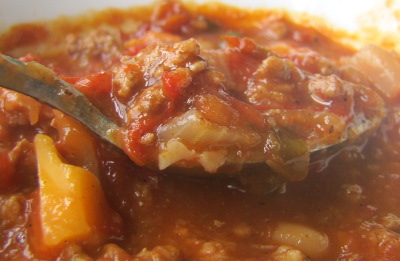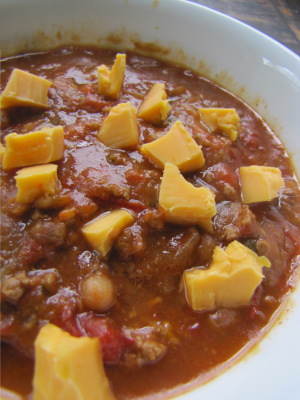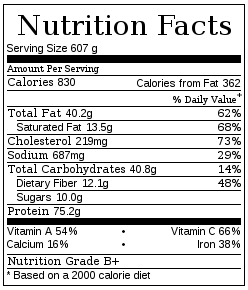
Basic lamb chili recipe
 I never really understood the
purpose of chili since I don't like spicy food or cooked green peppers
(and used to detest hamburger meat when I only ate the cheap
stuff.) But as we've been increasing the
protein content of our diets and decreasing the carbohydrates, I discovered that there are
chilis that push my cooked tomato buttons without being full of empty
carbohydrates. Plus, if you make it yourself, you can keep the
spiciness mild, leave out the green peppers, and use pastured
meat. This recipe serves 5.
I never really understood the
purpose of chili since I don't like spicy food or cooked green peppers
(and used to detest hamburger meat when I only ate the cheap
stuff.) But as we've been increasing the
protein content of our diets and decreasing the carbohydrates, I discovered that there are
chilis that push my cooked tomato buttons without being full of empty
carbohydrates. Plus, if you make it yourself, you can keep the
spiciness mild, leave out the green peppers, and use pastured
meat. This recipe serves 5.
- 1 pound of dried great northern beans
- 6 cups of homemade chicken stock. (Boil a chicken carcass
in water for a few hours and pour off the liquid to get stock.)
- 1 pound of ground lamb
- 2 onions
- 4 cloves of garlic
- 1 tbsp chili powder
- 1 tsp fresh thyme (or half as much dried oregano. Our thyme
is always ready to eat and tends to taste better than our oregano, so I
use it for everything.)
- 1 tsp salt
- 0.25 tsp pepper
- 4 cups of homemade spaghetti sauce (or about 8 cups of stewed tomatoes, 1 onion, three cloves of garlic, and some basil)
Soak the beans
overnight, then pour off the water. Add the chicken stock to the
beans and simmer until the beans are soft (about two or three hours.)
 Strain the beans through a
collander, tossing the liquid in a big pot along with one cup of the
beans. Freeze the rest of the beans for later meals.
(Clearly, you could have just started with fewer beans, but I've found
that I'm far more likely to add beans to a recipe if I have them cooked
up. Also, the bits of bean left in the stock thicken the chili
without requiring you to add cornstarch.)
Strain the beans through a
collander, tossing the liquid in a big pot along with one cup of the
beans. Freeze the rest of the beans for later meals.
(Clearly, you could have just started with fewer beans, but I've found
that I'm far more likely to add beans to a recipe if I have them cooked
up. Also, the bits of bean left in the stock thicken the chili
without requiring you to add cornstarch.)
Meanwhile, sautee the
lamb in a skillet until it's about halfway cooked (adding stock as
necessary to keep the meat from sticking to the pan.) Cut up the
onions and garlic and add them to the meat, continuing to cook over
medium heat until the onions are soft. Add in the chili powder,
thyme, salt, and pepper and sautee just a bit more, then pour
everything from the skillet into your pot of stock.
Throw in the spaghetti
sauce or tomatoes. (I only used spaghetti sauce because our
freeezer is nearly bare of tomato products. As I mentioned above,
you could instead use  about eight cups of stewed
tomatoes and add a bit more garlic and onion to the previous
step. I'm not sure if we could taste the basil.) Cook over
low heat for about an hour until the flavors meld together, or for two
hours if you started with stewed tomatoes and need them to lose some
liquid.
about eight cups of stewed
tomatoes and add a bit more garlic and onion to the previous
step. I'm not sure if we could taste the basil.) Cook over
low heat for about an hour until the flavors meld together, or for two
hours if you started with stewed tomatoes and need them to lose some
liquid.
The USDA's nutritional
guidelines gives this chili a B+, probably because they don't like all
of the fat and cholesterol in the chicken stock and lamb.
However, we're believers in the nutritional
goodness of fats from pastured animals, so I'd give it an A.
Of course, the meal needs some greens on the side to round it off, and
cheddar on top of the chili makes it a treat.
Want more in-depth information? Browse through our books.
Or explore more posts by date or by subject.
About us: Anna Hess and Mark Hamilton spent over a decade living self-sufficiently in the mountains of Virginia before moving north to start over from scratch in the foothills of Ohio. They've experimented with permaculture, no-till gardening, trailersteading, home-based microbusinesses and much more, writing about their adventures in both blogs and books.
Want to be notified when new comments are posted on this page? Click on the RSS button after you add a comment to subscribe to the comment feed, or simply check the box beside "email replies to me" while writing your comment.

Oh, I'm glad you've found a recipe that has helped you to discover just how yummy chili can be! I'm a homemade chili addict, personally, although I don't like spicy food either. But you can put just about anything that you want in it and have it turn out well. I've never made lamb chili, but I've used ground beef, ground chicken, ground turkey, sausages of various types, and just plain old beans (eaten with homemade tortilla chips to complete the protein in the beans). I'm also liable to throw loads of veggies in - depending on what I have in the garden and/or the freezer - including carrots, celery, parsnips, summer squash, winter squash (usually peeled, cubed and pre-cooked if I'm in a hurry), sweet potatoes (similarly prepared), various greens, green beans, corn, peas, etc. I put in the peppers too, but then I like cooked peppers. It's just such a versatile dish, it seems a shame that many people presume it's only for lovers of spicy foods (since most of what you come across in restaurants is inedible, it's so spicy) and give it a miss.
It's just such a versatile dish, it seems a shame that many people presume it's only for lovers of spicy foods (since most of what you come across in restaurants is inedible, it's so spicy) and give it a miss.
I am a bit curious about cooking the beans in broth, as I've always just used plain water. I've often heard that cooking beans with salt can make it more difficult for the beans to properly soften. Is your broth unsalted? Does the fat content of the broth affect how the beans cook? Do the beans take on the flavor of the broth? I think I'll have to try it myself next time I make chili, just to see how it works! Thanks for the recipe!
Thanks for the recipe!
I'll definitely be adding more vegetables to this next time, although I guess the trick is not to turn it into a vegetable soup. (For me, everything turns into a vegetable soup if I'm not careful...)
(For me, everything turns into a vegetable soup if I'm not careful...)
I make my own broth, so it's unsalted, and it doesn't seem to keep the beans from getting soft. (If anything, they got oversoft in the couple of hours I cooked them.) I tend to use homemade broth as the base for everything, to add a bit of flavor and also because bone broths are supposed to be very good for you (and I hate to waste any part of real meat.) I'm not sure it's enough flavor on its on to make plain beans interesting, but broth certainly does seem to add a bit of complexity to flavors of soups and such.